What Category Management tells us about the future of procurement

What is Category Management and why does it matter?
It’s been called a lot of things: strategic procurement, Category Management, strategic commissioning and customer centric procurement. What it really should be called is “good procurement practice”.
Of course that is not as flashy as the other badges. But it highlights the importance of actually starting on the journey to help procurement stay relevant into the future.
For most organisations, Category Management has promised a lot and delivered very little. Many find that they have rebadged procurement and purchasing managers as “category managers” but haven’t seen advantages flow through to their organisation.
Some organisations are only focussing on aggregating spend and market testing to achieve lower prices and as a result are missing out on other opportunities to drive down spend. For others Category Management is still an unknown or untested approach.
Read on to really understand what the key ideas behind Category Management are and how they will help you transform your procurement function to extract greater value.
Category Management varies from organisation to organisation. O’Brien* defines Category Management as:
The practice of segmenting the main areas of organisational spend on bought-in goods and services into discrete groups of products and services, according to the function of those goods or services and, most importantly, to mirror how individual marketplaces are organised. Using this category segmentation, organisations work cross-functionally on individual categories, examining the entire category spend, how the organisation uses the products or services within the category, the marketplace and individual suppliers.
Category Management:
- is seen as managing product categories as “business units” and customising them on a very focused basis in order to satisfy customer needs
- transforms “buyers” into entrepreneurs, each responsible for a small business within the larger enterprise. The Category Manager becomes CPO or even CEO of their category
- is a continuous and embedded process operating within a strategic procurement framework that has the agility to meet the demands of a dynamic supply market and business.
*Jonathan O’Brien (2015), Category Management in Purchasing.
Category Management vs the traditional approach to procurement
Traditionally, procurement follows a sequential, step by step process (see Figure 1). The goal of this process is to ensure compliance with a contract that provides best value for money. There is a degree of interaction between the procurement team and their internal “customers” who are typically located outside of the procurement team within the business areas. Often these customers provide input into the development of the specifications or scope of work.

In the example of uniforms, there is a whole supply chain that makes sure the right uniforms are delivered to the right employee. Procurement has an important role in this supply chain, as depicted in Figure 2.
Let’s take a helicopter ride. Let’s leave the confines of the procurement department and have a look at your organisation as a whole.
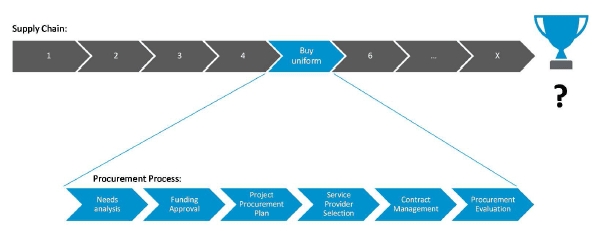
From the helicopter’s perspective, we start to see what the rest of the supply chain looks like and also how every part of it contributes to the overall process objective. In this case the process objective is that “staff members able to correctly conduct their activities in a safe way”.
Category Management, unlike traditional procurement, is not a step within this supply chain. It is not confined to a single box of the process. Instead, it asks at every step of the process how to better deliver the outcome, with the process objective in mind (see Figure 3).
It therefore is a method that is used to improve the process, the whole supply chain, to ensure the process objective is achieved in the most effective, efficient and appropriate way. It “attacks” the supply chain and asks questions about how to do it better, every step of the way. How to do it better may include running a traditional procurement process, but that is just one of the many instruments known to Category Management.
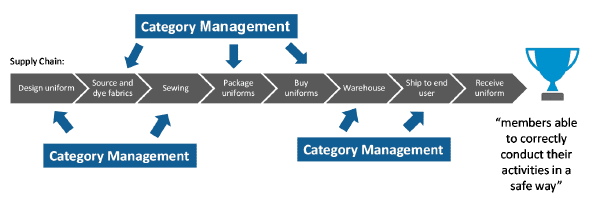
Benefits of Procurement Category Management
A question that is asked a lot is “why should we change something that is not broken?”. Figure 4 demonstrates that, on average, there are no additional savings that organisations can achieve from running yet another tender process or by simply aggregating the volume from across the organisation. These days are over and the first wave of procurement savings has been realised.
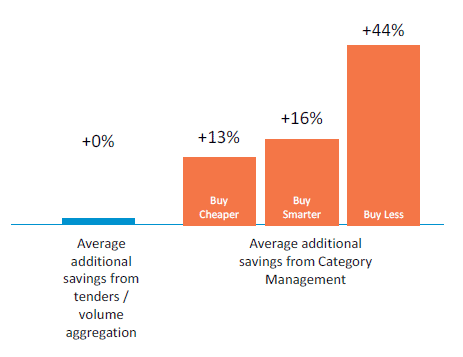
What Grosvenor’s 2015 CPO study found is that organisations using advanced spend levers that are typical for a Category Management approach can reap additional savings of up to 44% (see Figure 4).
Figure 5 below shows and defines the four spend levers that are available to your organisation. Category Management especially emphasises the importance of Buy Cheaper, Buy Less and Buy Smarter.
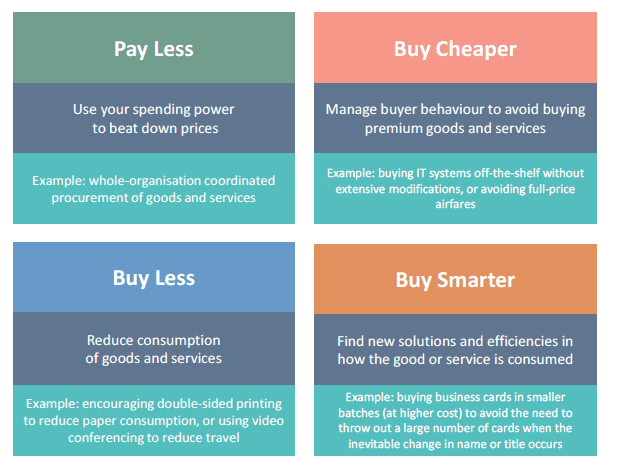
The following table lists potential opportunities that can be identified in a category:
| PAY LESS | BUY CHEAPER |
|
|
| BUY LESS | BUY SMARTER |
|
|
Our study found that in addition to financial benefits, Category Management, and especially the Buy Smarter spend lever, provides non-financial benefits as well:
- higher quality
- quicker delivery
- better relationships
- lower risk
- higher innovation.
Moving from a silo to facilitating and influencing group effort
In a traditional procurement organisation, the procurement team is often a gatekeeper for suppliers to gain access. The method of choice is running a procurement exercise, such as a Request for Tender (RFT) or Request for Quote (RFQ) to compare suppliers and their offerings.
Procurement has direct relationships with the legal, finance and other support functions within the organisation. They also engage with business representatives, often in an ad-hoc, project specific way. Suppliers also talk to these same stakeholders, often without procurement being aware or present.
Category Management breaks this siloed thinking (see Figure 6). Achieving better outcomes for the whole of the organisation is a group effort. Often facilitated by procurement, it includes an open approach and discussion between all stakeholders. This may also include external experts who know exactly how to cut corners to optimise the supply chain for a specific category.
In this new role, procurement does not have the luxury of handing out templates and policing compliance. Category Management involves decisions that are outside of procurement’s direct sphere of control. To drive results, the procurement team has only one tool to achieve better outcomes: influence.
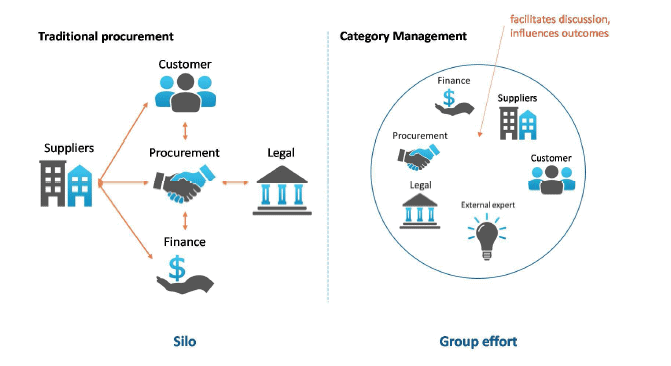
Turning your focus internally
The additional savings from Category Management don’t come for free of course. Category Management changes the tasks expected to be performed by the typical procurement professional, as depicted in Figure 7 below.

A focus on external supply and getting the best results from suppliers is of course part of Category Management. But even more so, Category Management also includes a strong internal focus. Working with internal stakeholders to influence them to substitute bells-and-whistles solutions with-fit-for-purpose goods and services drives significant savings.
Especially in the public sector. The highest savings, however, result from the reducing of consumption volume. Again, Category Management will work with internal stakeholders and put policies in place to reduce demand. Further opportunities can be gained from optimising internal back office processes, again the procurement team would work closely with internal stakeholders to realise these opportunities.
While keeping an eye of the total cost of supply, Category Management tries to optimise the total cost of process, or Total Cost of Ownership (TCO). This will sometimes mean not buying the product that has the lowest per unit cost. In fact it may sometimes mean buying the product with the highest price tag. Minimising the TCO means taking secondary cost for installation, user training and integration into account. This might mean that sometimes, a more expensive good might be purchased as an input into a specific area of the supply chain, when this reduces cost elsewhere.
Traditionally, procurement looks at all contracts of an organisation, one at a time. The program is often driven by expiring contracts. Contracts that expire first get attention first. Category Management looks at the bundle of contracts that constitute a category. To improve the efficiency, effectiveness and appropriateness of these categories, the category manager would look at all contracts at the same time, no matter when they expire. Implementing the improvements could even lead to the cancellation of an ongoing contract and the amalgamation of several contracts into one, or even change the service delivery model.
Prioritising your effort
One important commercial principle is that of prioritisation. When resources, such as time and people, are scarce, organisations focus on what is most important and what can be achieved with minimal resource allocation. Figure 8 provides guidance on how categories can be prioritised.

The complexity dimension takes into consideration how many resources will be required to optimise the given category. If the total spend, the level of risk involved or the number of stakeholders are high, then the effort for change management in this category is also high.
The alignment with business strategy distinguishes those categories that are important to fulfil the organisation’s overall goals from those which are a second priority.
These two dimensions build a matrix of four priority groups. Each category of spend can be placed within this matrix.
Quick-wins are typically low in effort but high in impact. If your organisation focusses here first, the category managers can quickly demonstrate that Category Management is worthwhile doing through achieving fast and measurable outcomes.
The highest effort should be associated with the “strategically important” categories. The momentum gained through implementing quick wins, will get the category managers through the longer term implementation of changes to these categories.
Operational efficiencies are often possible in categories that are high risk and/or high spend but don’t have an immediate link to the strategic direction of the organisation. For example, travel, fleet or other indirect categories often fall into this quadrant.
Where possible, category managers would stay away from categories in the “distractions” quadrant. There is little to gain from these categories and they are also not strategically important. Time and people will typically be allocated to these once all other initiatives have been implemented. To drive administrative efficiencies in these categories, organisations often implement purchase cards or corporate credit cards.
What Category Management entails
Category Management does not follow a linear but iterative methodology. Instead category managers have access to a “toolbox” of skills and knowledge, which they use to identify and analyse cost drivers, value drivers, stakeholders, spend, market information and decisions around strategic commissioning.
Discovery of information in one area may lead to the category manager revisiting information in a different area. For example, spend analysis may identify additional stakeholders or cost drivers that were previously unknown. Even the mapping of the process may change as additional steps are uncovered through stakeholder engagement.
Figure 9 depicts that establishing Category Management for a given category starts with defining the process objective. The category manager then maps the process before proceeding with the analysis of each process step. This analysis considers:
- cost drivers and value drivers
- spend
- stakeholders
- market capability and market capacity.
The information gathered up to this stage then informs the make or buy / commissioning decision. Understanding where the gaps to current practice are is a secondary task as category analysis is predominantly interested in how the process “should” look like rather than what it “does” look like.
Identify opportunities along the whole process to achieve better customer outcomes
The information is then used to identify opportunities along the whole process, which will include opportunities to pay less, buy cheaper, buy less and buy smarter. The insights from category analysis and the identified opportunities will then be incorporated into a category plan, which serves the purpose to communicate the strategic direction for the category to all stakeholders and which sets out the roadmap for implementation.

A high level implementation plan would be included in the Category Plan. It is then up to the category manager to refine and action the details of how to capture each opportunity. Often this includes running a procurement. Many opportunities will be achieved through non-procurement activities, such as policy changes (ie “we will only assess stock levels for consumables once a fortnight”).
Performance against the plan should be measured regularly and the plan should be a living document that is updated to reflect any changes. Remember, only measure what you can manage.
Have a category management question? Ask Stefan Gassner







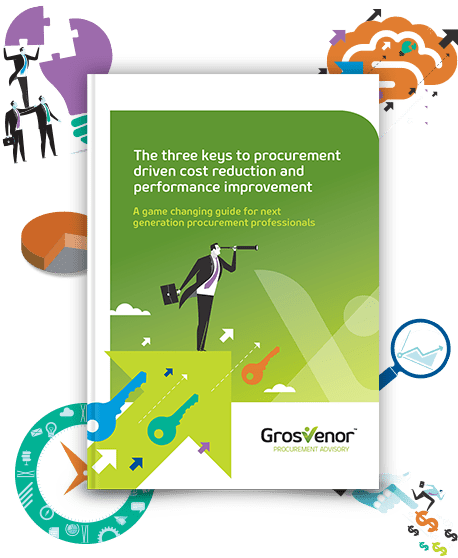

 We are all about sharing our expertise to help you and your organisation be the best it can be.
We are all about sharing our expertise to help you and your organisation be the best it can be.